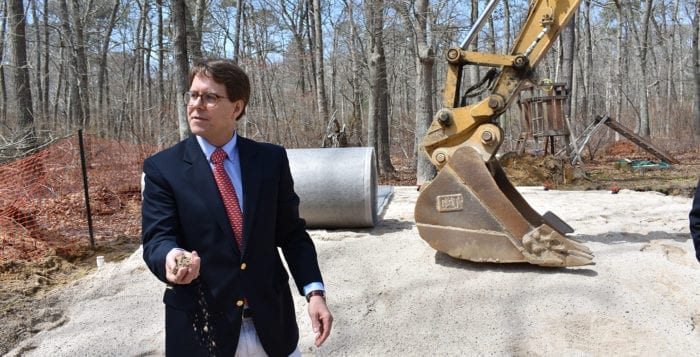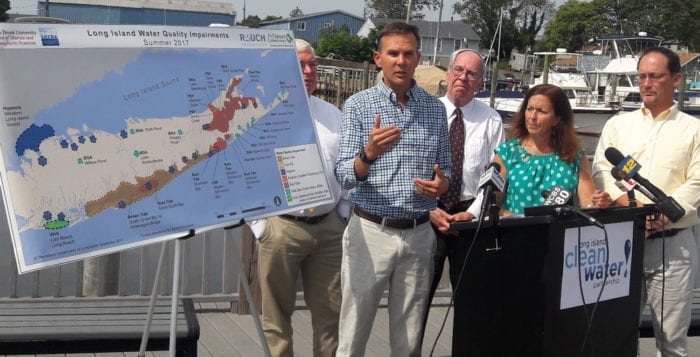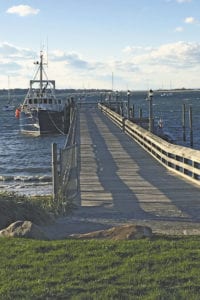Scientists and engineers from Stony Brook University are planning to use two plentiful Long Island resources to save its coastal waters from nitrogen pollution: sand and wood chips.
Members of the New York State-funded Center for Clean Water Technology at Stony Brook University unveiled their nitrogen-reducing biofilter April 26 at a Suffolk County-owned home in Shirley.
“We have made a huge commitment to protect and preserve our land as we are protecting the groundwater below,” said New York state Sen. Ken LaValle (R-Port Jefferson). “We are zeroing in on our water, and we are making a major commitment with systems like these.”
“The results that we’ve gained have been very exciting.”
— Howard Walker
Through the system, waste from the home is first pumped into a septic tank. After the septic tank the effluent is moved into a separate system that trickles down by gravity, first going through a sand layer where bacteria turns the nitrogen into nitrite and nitrate. The waste then goes through another layer of sand and wood chips designed to turn the nitrite/nitrate into nitrogen gas that will go into the atmosphere, instead of into the ground and thus Long Island’s water.
The system being built in Shirley is one of three the center is testing as part of Suffolk County’s bid to create a nitrogen reducing home wastewater system.
“We have outstanding professionals who are helping to guide these efforts,” Deputy County Executive Peter Scully said. “We should be able to involve ourselves in the designing of the next generation of this technology, bringing the cost down [and] making the technology more effective.”
One of the biggest problems for Long Island’s coastal waters has been hypoxia, a state caused by excess nitrogen, where the oxygen level in water is below the necessary levels to support life. It affects fish, clams and any underwater plant life. Last year co-director of the Center for Clean Water Technology, Christopher Gobler and other researchers from the Long Island Clean Water Partnership, concluded there were cases of hypoxia in Stony Brook Harbor, Northport Bay, Oyster Bay, Hempstead Bay as well as waters all along both the North and South shores.
In 2015 Suffolk County Executive Steve Bellone (D) called nitrogen pollution the county’s “environmental public enemy number one.” Since then the county has worked with local scientists and engineers to craft technology that could replace Long Island’s old cesspool and septic tanks.
The benchmark for total amount of nitrogen allowed from any of these new systems is 19 milligrams of nitrogen per liter. Co-director at the Center for Clean Water Technology, Howard Walker, said that initial tests of the system have reached well below that threshold.
“We’re seeing less than 10 milligrams per liter of total nitrogen coming from the systems in the prototypes we’ve been testing for the past year and a half,” Walker said. “The results that we’ve gained have been very exciting.”
“We are zeroing in on our water, and we are making a major commitment with systems like these.”
— Ken LaValle
The purpose of the prototypes is to gauge the effectiveness of the system as well as find ways to reduce the price and size of the filter. The center hopes the system will be affordable since all the parts could be bought from plumbing or pool supply stores. Gobler said the system currently costs several tens of thousands of dollars in its prototype stage, but he hopes the cost will come down with more tests.
“This is nonproprietary — all other systems are built off of Long Island and then brought here, this one is using Long Island materials, Long Island labor,” Gobler said. “Ultimately without having to run a company or without having to buy something off the shelf, there’s a promise to make these highly affordable.”
Other nitrogen filters have problems when it comes to people flushing any kind of bleach, pharmaceuticals or other harmful chemicals because they kill off the bacteria that remove the nitrogen from the effluent, according to Gobler. He said the design of SBU’s nitrogen-reducing biofilter will be less prone to failure because the waste is spread over a large area, and because it seeps through the layers of sand at a slower rate the killing effect of chemicals would be reduced.
“One bad flush is not going to upturn the apple cart,” Gobler said. “We’ve tested more than 30 different organic compounds, pharmaceuticals, personal care products, drugs, and in all cases its removing 90
percent of those compounds, sometimes 99 percent. In certain cases, it’s just as good or even better than a sewage treatment plant.”
The Center for Clean Water Technology hopes to have concrete results on its prototypes in a year’s time. After that a provisional phase would take place where the center would install another 20 filters in other parts of Long Island.









